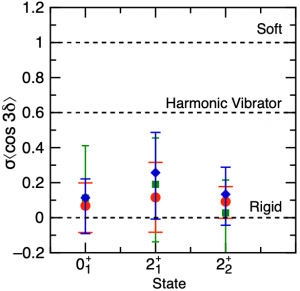Research Highlights
Evidence for rigid triaxiality in 76Ge
 Neutrinoless double-beta (0νββ) decay is one of the most promising experimental techniques capable of probing the fundamental properties of the neutrino. The observation of this rare weak-interaction process would signal a violation of total lepton number conservation and establish the Majorana nature of the neutrino; e.g., that the neutrino is its own antiparticle. In addition, the measured 0νββ half-life would provide experimental access to the absolute neutrino mass scale, provided that the nuclear matrix elements (NMEs) mediating the decay are reliably known. However, results of nuclear structure calculations of the NMEs differ by up to a factor of three, and this translates into an order of magnitude variation in the decay lifetime. Consequently, it has been suggested that extracting an effective neutrino mass will require an understanding of the NMEs with at most a 20% theoretical uncertainty. In order to achieve this precision, experimental structure input is necessary as it can provide much needed constraints and allow models to be selected or developed based on reproducible benchmarking criteria.
Neutrinoless double-beta (0νββ) decay is one of the most promising experimental techniques capable of probing the fundamental properties of the neutrino. The observation of this rare weak-interaction process would signal a violation of total lepton number conservation and establish the Majorana nature of the neutrino; e.g., that the neutrino is its own antiparticle. In addition, the measured 0νββ half-life would provide experimental access to the absolute neutrino mass scale, provided that the nuclear matrix elements (NMEs) mediating the decay are reliably known. However, results of nuclear structure calculations of the NMEs differ by up to a factor of three, and this translates into an order of magnitude variation in the decay lifetime. Consequently, it has been suggested that extracting an effective neutrino mass will require an understanding of the NMEs with at most a 20% theoretical uncertainty. In order to achieve this precision, experimental structure input is necessary as it can provide much needed constraints and allow models to be selected or developed based on reproducible benchmarking criteria.
While considerable information is available on nucleon occupancies and on the structure of low-lying states, present studies lack the required level of sensitivity to collective degrees of freedom which have been shown to significantly impact the calculated NMEs. Among the isotopes considered, the 0νββ decay of 76Ge into 76Se possesses high discovery potential and is currently the focus of the GERDA and MAJORANA collaborations. For this parent-daughter pair, theoretical NMEs differ by factors of 2-3 between different shell-model approaches and by as much as 5-6 between quasi-particle random phase approximation and energy density functional ones.

Thus, to provide data to constrain these calculations, a high-statistics, multi-step Coulomb excitation experiment was carried out at the ATLAS facility at Argonne National Laboratory by the UNC/TUNL, USNA, U. Maryland collaboration with the GRETINA γ-ray tracking spectrometer and the CHICO2 array of position-sensitive parallel plate avalanche counters. The nature of triaxial deformation in 76Ge was derived from the shape parameters deduced on the basis of an extensive rotational-invariant sum-rule analysis. The latter is model independent within the general framework of the collective model; it enables the determination of the deformation parameters from the measured E2 matrix elements without any assumption about the nuclear shape.
The approach provided considerable insight into the underlying collectivity of the ground-state and γ bands. Both sequences were determined to be characterized by the same β (∼0.3) and γ (30∞) deformation parameters. In addition, compelling evidence for low-spin, rigid triaxial deformation in 76Ge was obtained for the first time from the analysis of the statistical variance of the quadrupole asymmetry deduced from the measured matrix elements. Consequently, these observations directly impact the NMEs relevant for 0νββ: the various theoretical approaches will have to reproduce the parent 76Ge as a rigid triaxial rotor, while also allowing for triaxiality in the 76Se daughter. In the latter case, recent results also indicate a significant triaxiality with a dominant prolate component, but the degree of rigidity could not be determined. The potential might well be softer in this instance, as the odd-even staggering in the γ band is opposite to that seen in 76Ge, but is in line with that reported for the other even Se and Kr isotopes of the region.
The results of this study are published in Physical Review Letters, a premier journal of the American Physical Society: Phys. Rev. Lett. 123, 102501 (2019)
